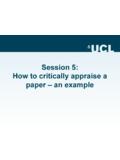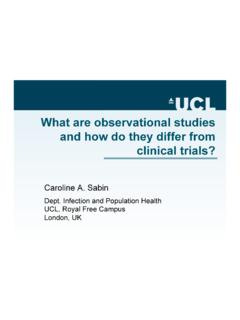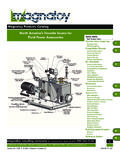Transcription of What is bias and how can it affect the outcomes from research?
1 What is bias and how can it affect the outcomes from research ? Caroline A. Sabin Dept. Infection and Population Health UCL, Royal Free Campus London, UK Bias Bias occurs when there is a systematic difference between the results from a study and the true state of affairs Bias is often introduced when a study is being designed, but can be introduced at any stage Appropriate statistical methods can reduce the effect of bias, but may not eliminate it totally Increasing the sample size does not reduce bias Preferable to design the study in order to avoid bias in the first place Bias Many forms of bias exist these can broadly be categorised as forms of: - Selection bias - patients included in the study are not representative of the population to which the results will be applied.
2 Or - Information bias - occurs during data collection when measurements on exposure and/or outcomes are incorrectly recorded in a systematic manner Selection bias Ascertainment bias Attrition bias (loss-to-follow-up) Healthy entrant effect Response bias Survivorship bias* Confounding* Survivorship bias Occurs when survival is compared in patients who do/do not receive an intervention, when this becomes available sometime in the future To receive the intervention, patients must survive until its introduction; anyone dying prior to this time will not receive it It will appear that those who receive the intervention have particularly good survival compared to those who do not receive it Example Mortality rates after HIV infection stratified by receipt of HAART No HAART HAART Royal Free Hospital Haemophilia Cohort, June 2005 Example End-stage liver disease in men with haemophilia co-infected with HIV/HCV MV Ragni et al; Haemophilia; 2009; 15.
3 552-558 Bias due to confounding Occurs when a spurious association arises due to a failure to fully adjust for factors related to both the risk factor and outcome Commonly encountered in cohort studies Confounding factor outcome Factor of interest Confounding treatment comparisons The reason why some patients were treated with one regimen and others with a different one is often unknown Whilst one treatment may appear to be associated with a better outcome , these other factors may explain the better outcome in these patients Often referred to as channelling bias in this context Example - Abacavir (ABC) and MI The D:A:D Study reported a significant association between recent exposure to ABC and the development of MI Adjusted rate ratio: , 95% CI Finding was unexpected as ABC was perceived to be a cardio-friendly option; in some clinics, ABC was preferentially used in those with existing cardiovascular risks Confounding example Family history of CVD Future development of MI Treatment with ABC or other NRTI Features of patients starting each NRTI for the first time in the D:A:D Study Patients starting: AZT ddI d4T 3TC ABC Number of patients 5504 3593 2347 6718 7359 Male sex Older age BMI>26 kg/m2 Current/ex smoker Family history of CVD Diabetes Hypertension Dyslipidaemia Moderate/high CHD risk * Cell entries are the proportion of patients receiving each drug who fall into each category.
4 Patients may fall into >1 category if they started >1 drug over follow-up Adapted from: D:A:D Study Group. Lancet 2008; 371: 1417-1426 Dealing with confounding We use statistical methods ( multivariable regression, propensity scores) to remove the effects of confounding Estimates from these models describe the relationship between a drug and a toxicity, after removing the effects of known confounders Whilst this approach is usually successful, all methods will give biased results if unmeasured (or unknown) confounding remains Channelling bias in D:A:D? Findings unlikely to be explained by channelling bias as: - Association was significant after adjusting for known CVD risks - Association was reduced in those who discontinued ABC, suggesting effect was reversible - No association apparent for stroke, although likely to be similar channelling - No association apparent for tenofovir, although likely to be similar channelling Information bias Central tendency bias Lead-time bias* Measurement bias Misclassification bias Observer bias Regression dilution bias Regression to the mean Reporting bias Publication bias* Missing data* Lead-time bias Clinical outcomes are generally better in those who start HAART at a higher CD4 count This has been used as justification for recommending that HAART is started at a higher CD4 count However.
5 Those starting treatment at lower CD4 counts have generally remained well long enough for their CD4 counts to fall to this level Furthermore, patients who died before their CD4 count fell to this level would be excluded from the analysis Lead-time bias survival HAART Time since start of therapy 50 cells/mm3 350 cells/mm3 Lead-time bias survival after HAART Time since start of therapy 50 cells/mm3 350 cells/mm3 Time since CD4 350 50 cells/mm3 350 cells/mm3 Lead-time 350 cells/mm3 Lead-time bias Studies that compare outcomes among individuals starting HAART at different CD4 levels should not be used as evidence that HAART should be started earlier Appropriate analyses attempt to fill-in the unmeasured time from a common baseline, and information on patients who are likely to have died before reaching the lower CD4 level NA-ACCORD, When to Start consortium Publication bias Studies showing significant results are more likely to be published than those showing non-significant results Bias is generally less marked when the study is large When performing a systematic review it is important to obtain information on all studies performed, whether or not they have been published ( abstracts, all journals including non-English language ones)
6 Dealing with bias due to missing data Data are often missing in observational databases This doesn t reflect poor patient management, but reflects changing trends in patient monitoring as well as restricted access to laboratory data If data are missing at random , then analyses that exclude these patients will lack power If the data are not missing randomly, then the results of analyses may be biased Multiple imputation methods can be used Example dealing with bias in cohorts We wished to describe the risk of hepatotoxicity in patients treated with nevirapine (NVP) compared to those treated with efavirenz (EFV) As NVP treatment has already been associated with an increased risk of hepatotoxicity, it is likely that patients with high baseline ALTs will be treated with an alternative drug This may confound any relationships with outcome we must adjust for the baseline ALT in any analysis Is NVP associated with a higher rate of liver abnormalities than EFV?
7 Eligible patients: all ARV-na ve patients in UK CHIC who started treatment with either NVP (n=1785) or EFV (n=4338) from 1/1/2000 to 1/1/2006 (n=6123) Data from patients receiving NVP+EFV (n=24) shown for comparison outcome variable: First ALT>200 IU after starting HAART Time to first ALT>200 IU among ARV-na ve patients starting EFV or NVP EFV NVP Probability of ALT >200 IU (%) Weeks after starting HAART Time to first ALT>200 IU among ARV-na ve patients starting EFV or NVP Estimate EFV vs NVP Relative hazard 95% CI P-value Unadjusted Availability of baseline measurements Initial HAART regimen Baseline ALT measurements NVP EFV NVP+EFV P-value Any ALT prior to start of HAART 472 ( ) 2066 ( ) 20 ( ) Median (IQR) baseline ALT 26 (18, 38) 29 (21, 45) 37 (24, 44) N (%) with baseline ALT >200 IU 0 (-) 27 ( ) 0 (-) Estimate EFV vs NVP Relative hazard 95% CI P-value Unadjusted Adjusting for baseline ALT (including category for missing)
8 Time to first ALT>200 IU among ARV-na ve patients starting EFV or NVP Estimate EFV vs NVP Relative hazard 95% CI P-value Unadjusted Adjusting for baseline ALT (including category for missing) Adjusting for baseline ALT (excluding those without values) Time to first ALT>200 IU among ARV-na ve patients starting EFV or NVP Availability of follow-up measurements Initial HAART regimen Follow-up ALT measurements NVP EFV P-value Any ALT measurement in first year after starting HAART 511 ( ) 2053 ( ) ALT available at 48 weeks after starting HAART 250 ( ) 937 ( ) Median (IQR) ALT (IU) at 48 weeks 26 (18, 43) 26 (18, 40) Summary If possible, should design studies to minimise the opportunities for bias During analysis, must question whether bias may have been introduced at any stage ( through loss-to-follow-up, missing data, differential follow-up, etc.)
9 Appropriate statistical methods may be used to minimise the impact of bias, but are unlikely to remove it fully


![Index [www.fandept.com]](/cache/preview/8/2/1/7/a/e/c/d/thumb-8217aecd553b7e6a7bea5aba32403881.jpg)







